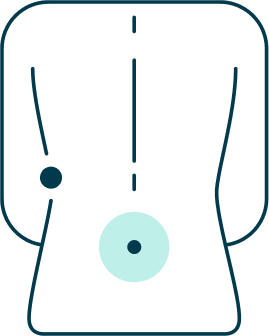Intradiscal techniques
Intradiscal techniques in pain management
Intradiscal techniques include those procedures in which we access the interior of the damaged disc and administer substances or perform procedures for therapeutic purposes to treat pain.

Types of intradiscal techniques
For discogenic pain
- Treatment with methylene blue: a substance with anti-inflammatory capacity that reduces the painful stimulus produced inside the disc.
- Stem cell treatment: anti-inflammatory and regenerative treatment that improves the condition of the intervertebral disc.
- Radiofrequency treatment (biacuplasty): this technique reduces the conditions inside the disc that cause pain inside the disc.
For radicular pain
- Treatment with gel-like substances with the capacity to be reabsorbed from the protruded or herniated disc itself and with a powerful anti-inflammatory action.
- Treatment with radiofrequency and subtraction of part of the disc: technique that allows to reduce by means of electricity the protruded / damaged disc reducing the compression of the nerve and thus the inflammation that produces the pain of the leg. Thanks to the use of a subtraction system, part of the disc compressing the nerve can be removed.
- Laser treatment: a technique that reduces the amount of protruded or damaged disc, decreasing the compression of the nerve and thus the inflammation that causes leg pain.
For which pathologies is it indicated
For which pathologies is treatment by intradiscal techniques indicated?
- Discogenic pain
- Radicular pain (or sciatica)
Procedure
In order to correctly apply the treatment by means of intradiscal techniques and to obtain the effectiveness that it can provide, a correct diagnosis and evaluation of the patient will be essential. For this, a medical visit is essential, in which the doctor will ask specific questions that, together with the physical examination and evaluation of the complementary tests, will make it possible to determine more precisely the cause or causes of the pain. The specific treatment will be applied according to each case and taking into account the pathology that we are going to address.
- No hospitalization is required in most cases.
- Mild degrees of sedation can be applied together with local anesthesia.
Frequently asked questions on the treatment of intradiscal techniques
What happens when you have plasma injected into your spine?
When Platelet Rich Plasma (PRP) is injected into the spine (whether in a disc, joint or muscle), it introduces growth factors that promote healthy tissue regeneration, reduce inflammation and decrease pain. Unlike corticosteroids that only reduce inflammation, PRP seeks a biological repair and a more lasting solution.
Who should not have platelet-rich plasma?
Not recommended for people with:
- Coagulation disorders.
- Active infections in the area to be treated.
- Cancer or uncontrolled autoimmune diseases.
- Pregnant or breastfeeding women.
What should you not do after an infiltration?
During the first 24-48 hours, it is recommended to avoid intense physical exertion. Heat, massage or anti-inflammatory drugs should not be applied unless indicated by the physician, especially after PRP infiltration.
Am I a candidate for spinal infiltration?
You are a good candidate if you suffer from low back pain or sciatica that does not improve with conservative treatments (medications, physiotherapy). Infiltrations are very effective for herniated discs, spinal stenosis or facet arthrosis. A specialist will evaluate your case to determine the best treatment for you.
Is the procedure painful? What is a session like?
No, the procedure is not painful. It is performed on an outpatient basis under local anesthesia. You will feel an initial prick, but the rest of the process is painless. The session lasts only a few minutes and you can go home the same day.
What results can I expect and how long will it take?
Many patients experience significant pain relief in the first few days or weeks after the procedure. The goal is to reduce pain enough so that you can resume your daily activities and actively participate in a rehabilitation program.

Our customers say
Insurance companies
Ask your MIVI centre for information on the agreements with insurance companies.










